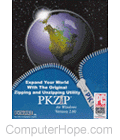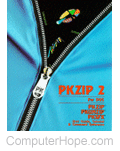PKZIP and PKUNZIP
PKZIP for Windows

Version 2.70 is the latest version of PKZIP for Windows and is used for Microsoft Windows users and includes the features below.
- The ability to create self extracting EXE files.
- Support for ZIP, TAR, GZIP, MIME, BinHex, UUecode, and XXencode.
PKZIP for DOS

Version 2.50 is the latest version of PKZIP for DOS and is used at the command line of MS-DOS and includes the below features.
- Supports long file names.
- Capability of compressing over 16,000 files.
- Additional compression options.
- Continues to use 2.04g command line syntax.
- Y2K compliant.
Technical Support
PKZIP for Windows
Currently, no known issues.
PKZIP for DOS
How do I ZIP files that are larger than one diskette onto multiple diskettes?
To do this, you would use the below syntax.
pkzip [directory] [diskfilename] -&.
Example:
pkzip c:\windows\*.* a:\windows.zip -&.
The -& is the important part of the above line and is telling pkzip to place your files onto multiple disks.
Will I be able to unzip a program with WinZip I zipped in PKZIP?
Assuming the file was zipped correctly, any file with the .zip extension can be pkunziped, and unzipped in WinZip or another compression utility.
Do you have a listing of available switches used at the command line?
PKUNZIP (R) FAST! Extract Utility Version 2.04g 02-01-93 Corp. 1989-1993 PKWARE Inc. All Rights Reserved. Registered version PKUNZIP Reg. U.S. Pat. and TM. Off.
Usage: PKUNZIP [options] zipfile [@list] [files...]
| -c[m] | Extract files to console [with More]. |
| -d | Restore/create directory structure stored in .ZIP file. |
| -e[c|d|e|n|p|r|s] | Extract files. Sort by [CRC | Date | Extension | Name| Percentage | Reverse | Size]. |
| -f | Freshen files in destination directory. |
| -j|J<h,r,s> | Mask|don't mask <Hidden/System/Read-only> files (def.=jhrs). |
| -n | Extract only newer files. |
| -o | Overwrite previously existing files. |
| -p[a/b][c][#] | Extract to printer [Asc mode,Bin mode,Com port] [port #]. |
| -q | Enable ANSI (American National Standards Institute) comments. |
| -s[pwd] | Decrypt with password [If no pwd is given, prompt for pwd]. |
| -t | Test .ZIP file integrity. |
| -v[b][r][m][t] | View .ZIP [Brief][Reverse][More][Technical] sort by [CR.|. |
| [c,d,e,n,o,p,s] | Date|Extension|Name|natural Order(default)|Percentage|Size]. |
| -x<filespec> | Exclude file(s) from extraction. |
| -$ | Restore volume label on destination drive. |
| -@listfile | Generate list file. |
| -3 | Disable 32-bit instruction usage on 80386 or higher CPU's. |
| -^ | Echo the command line. |
| -+ | Disable EMS (expanded memory specification) usage. |
| -- | Disable XMS (UMB/HMA memory) usage. |
| -) | Disable 32 bit DPMI (DOS Protected Mode Interface) usage. |
You can default any of these options with the PKUNZIP environment variable. Consult the file ADDENDUM.DOC for further information.
PKWARE, Inc
9025 N. Deerwood Drive
Brown Deer, WI 53223
How PKZIP and most other compression software work
How does PKZIP work? PKZIP uses several methods of compressing data using seek out and eliminate redundant information within a file. With the redundant material removed, the file takes up less space. And because the information was redundant, PKUNZIP can restore that material when it unzips your file.
For example, consider the line below:
The rain in Spain falls mainly on the plain.
Normally the above statement would take 44 or more bytes of disk space because of the amount of words in the document. But this simple line contains a surprising amount of repetition. The letters "in" and the space after the word "in" are repeated at the ends of the words "rain" and "Spain" in the sentence. The letters "ain" occurs four times, the two-character sequence "n" plus a space occurs twice, and the three-character sequence "he" plus a space occurs twice. What if you replaced each duplicate occurrence of one of these strings with a special code, called a token, that would stand for the duplicated numbers? Each token would contain a much shorter number combination that told you how many characters (including spaces) to count backwards in the string and how may characters were duplicated. Then the line would look like:
The ra<3,2>Sp<9,4>falls m<11,3>ly on<16,2>t<34,3>pl<15,3>.
Data compression takes advantage of the way data is represented in the computer. The string's original form can be reduced to representative tokens. If the token is used repeatedly in a file (long strings of the character 0, for instance), that information can be stored in fewer bytes than the original string. Later, the representational list of tokens (compressed file) can be expanded to the original form ("uncompressed" file), without losing any of the original data.
The key to data compression is the ability to search a string of bytes, identify any sequences of repeated data, and represent the repeated data as tokens. Binary files often have long strings of zeros, and repeated sequences of machine data, which can be efficiently compressed as representative tokens.
